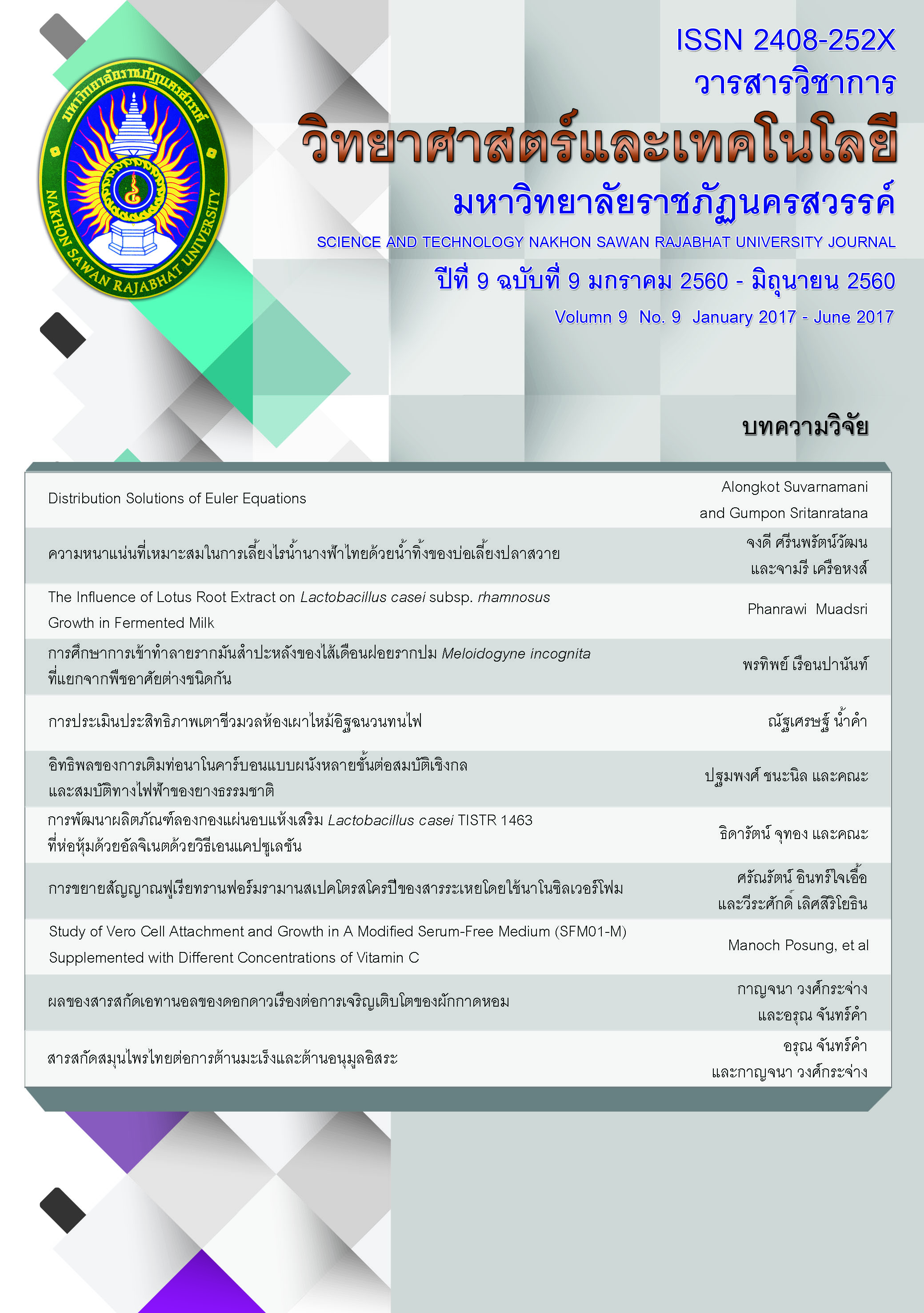The Influence of Lotus Root Extract on Lactobacillus casei subsp. rhamnosus Growth in Fermented Milk
Main Article Content
บทคัดย่อ
The infant intestinal tract is essentially sterile part and experiences a period of steady colonization over the following weeks and months as it is exposed to microorganisms from the environment. It is generally accepted that these microorganisms have a major impact on the overall development and function of the gastrointestinal mucosa and immune system. This research aims at prebiotic extraction from lotus root which is a plant in the local area. The study found that prebiotic extracted from lotus root gave the prebiotic concentration of 1,748 μg/ml. The optimum conditions for prebiotic extraction consisted of the extraction ratio, temperature and soaking time of 1:30 (w/v), 85 oC and 30 min, respectively. The growth of Lactobacillus casei subsp. rhamnosus in fermented milk supplemented with lotus root extract was investigated. Result showed that the fermented milk with prebiotic extract was able to promote growth of L. casei subsp. rhamnosus.
Article Details
เอกสารอ้างอิง
Barrangou R, Altermann E, Hutkins R, Cano R and Klaenhammer TR. (2003). Functional and comparative genomic analyses of an operon involved in fructooligosaccharide utilization by Lactobacillus acidophilus. Proc Natl Acad Sci USA. 100: 8957-8962.
Fuller R. (1989). Probiotics in man and animals. J Appl Bacteriol. 66: 365-378.
Fuller R. and Gibson GR. (1997). Modification of the intestinal microfolra using probiotics and prebiotics, Scand J Gastroenterol. 32: 28-31.
Gibson GR, Beatty ER, Wang X and Cummings JH. (1995). Selective stimulation of bifidobacteria in the human colon by oligofructose and inulin. Gastroenterology. 108: 975-982.
Gibson GR. and Roberfroid MB. (1995). Dietary modulation of the human colonic microbiota: introducing the concept of prebiotic. J Nutr. 125: 1401-1412.
Kaplan H. and Hutkins RW. (2000). Fermentation of fructooligosaccharides by lactic acid bacteria and bifidobacteria. Appl Environ Microbiol. 66: 2682-2684.
Majamaa H. and Isolauri E. (1997). Probiotics : a novel approach in the management of food allergy. J Allergy ClinImmun. 99: 179-185.
Mohd H, Haji R, Mohd. Rizuwan Y, Md. SJ, Mohd SS, Nurul SM, Asma AZ. (2013). An Overview on Mechatronic Application and Effectiveness of Developed Stand Alone Dioscorine Removal System. Journal of Automation and Control, 1(1): 1-5.
Niness KR. (1999). Inulin and oligofructose: what are they?. J Nutr. 129: 1402S-1406S.
Reddy BS. (1999). Possible mechanisms by which pro- and prebiotics influence colon carcinogenesis and tumor growth. J Nutr. 129: 1478S-1482S.
Sanders ME. (1999). Probiotics. Food Technology. 53(11): 67-77.
Santad W, Paiboon T, Akkasit J, Worrapanit C, Preeya H, Tipparat H, Arunporn I, Buncha O. (2011). Extraction and analysis of prebiotics from selected plants from s o u t h e r n T h a i l a n d. Songklanakarin J. Sci. Technol. Sep. - Oct. : 33 (5), 517-523.
Wollowski I, Rechkemmer G and Pool-Zobel BL. (2001). Protective role of probiotics and prebiotics in colon cancer. Am J Clin Nutr. 73: 451S-455S.


